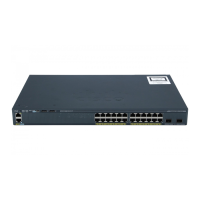Chapter 2: Switch Functionality 21
Section 2-2
d. Switch blocks
■ Each access layer switch has dual uplinks to two separate distribution
switches.
■ Use STP UplinkFast on access layer switches to reduce uplink failover time.
■ Use STP PortFast on access layer ports to reduce startup time for end users.
■ To load balance across the access layer uplinks, adjust the STP parameters so
that one access VLAN travels over one uplink while another VLAN travels
over the other uplink (Layer 2 distribution layer). Otherwise, adjust the
HSRP priorities in a Layer 3 distribution so that one distribution switch
supports one access VLAN and the other distribution switch supports
another VLAN.
■ If Layer 3 is used in the distribution layer, use passive interfaces toward the
access layer where no other routers reside.
5. Other considerations
a. For each VLAN, configure an STP root bridge and a secondary root bridge as
close to the core layer as possible. See section “7-2: STP Configuration,” in
Chapter 7.
b. Broadcast domains
■ Limit the size of broadcast domains by controlling the size of VLANs. It is
permissible to extend VLANs anywhere in the network, but broadcast traf-
fic will follow it.
■ Consider using broadcast suppression on switch ports. See section “11-1:
Broadcast Suppression,” in Chapter 11, “Controlling Traffic and Switch
Access.”
c. VLAN Trunking Protocol (VTP)
■ VTP Transparent mode is recommended as the best practice instead of VTP
client/server modes.
■ Use VTP manual pruning specific VLANs to be transported on trunks. This
reduces the unnecessary broadcast traffic on the trunks.
d. Scaling trunks
■ Bundle multiple trunk links together into an EtherChannel. For fault
tolerance, divide the EtherChannel across switch modules. See section “4-4:
EtherChannel,” in Chapter 4.
■ Do not configure trunk negotiation; use the “On” mode. See section “6-3:
Trunking,” in Chapter 6, “VLANs and Trunking.”

